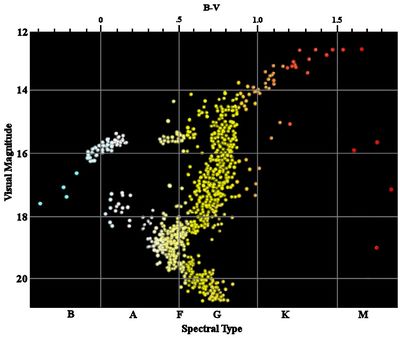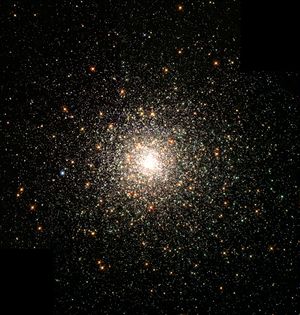عنقود مغلق
العنقود المغلق globular cluster هو spherical collection of stars that orbits a galactic core. Globular clusters are very tightly bound by gravity, which gives them their spherical shapes, and relatively high stellar densities toward their centers. The name of this category of star cluster is derived from the Latin, globulus—a small sphere. Occasionally, a globular cluster is known simply as a globular.
Globular clusters are found in the halo of a galaxy and contain considerably more stars, and are much older than the less dense open clusters, which are found in the disk of a galaxy. Globular clusters are fairly common; there are about 150[2] to 158[3] currently known globular clusters in the Milky Way, with perhaps 10 to 20 more still undiscovered.[4] Larger galaxies can have more: The Andromeda Galaxy, for instance, may have as many as 500.[5] Some giant elliptical galaxies (particularly those at the centers of galaxy clusters), such as M87,[6] have as many as 13,000 globular clusters.
Every galaxy of sufficient mass in the Local Group has an associated group of globular clusters, and almost every large galaxy surveyed has been found to possess a system of globular clusters.[7] The Sagittarius Dwarf galaxy, and the disputed Canis Major Dwarf galaxy appear to be in the process of donating their associated globular clusters (such as Palomar 12) to the Milky Way.[8] This demonstrates how many of this galaxy's globular clusters might have been acquired in the past.
Although it appears that globular clusters contain some of the first stars to be produced in the galaxy, their origins and their role in galactic evolution are still unclear. It does appear clear that globular clusters are significantly different from dwarf elliptical galaxies and were formed as part of the star formation of the parent galaxy, rather than as a separate galaxy.[9]
تاريخ الرصد
| اسم العنقود | اكتشفه | سنة |
|---|---|---|
| M 22 | Abraham Ihle | 1665 |
| ω Cen | إدموند هالي | 1677 |
| M 5 | گوتفريد كيرش | 1702 |
| M 13 | إدموند هالي | 1714 |
| M 71 | Philippe Loys de Chéseaux | 1745 |
| M 4 | Philippe Loys de Chéseaux | 1746 |
| M 15 | جان-دومينيك مارالدي | 1746 |
| M 2 | جان-دومينيك مارالدي | 1746 |
The first known globular cluster, now called M 22, was discovered in 1665 by Abraham Ihle, a German amateur astronomer.[10][11] However, given the small aperture of early telescopes, individual stars within a globular cluster were not resolved until Charles Messier observed M 4 in 1764.[12][13] The first eight globular clusters discovered are shown in the table. Subsequently, Abbé Lacaille would list NGC 104, NGC 4833, M 55, M 69, and NGC 6397 in his 1751–1752 catalogue.[أ]
مخطط اللون-القدر

الشكل

In contrast to open clusters, most globular clusters remain gravitationally bound for time periods comparable to the life spans of the majority of their stars. However, a possible exception is when strong tidal interactions with other large masses result in the dispersal of the stars.
After they are formed, the stars in the globular cluster begin to interact gravitationally with each other. As a result, the velocity vectors of the stars are steadily modified, and the stars lose any history of their original velocity. The characteristic interval for this to occur is the relaxation time. This is related to the characteristic length of time a star needs to cross the cluster as well as the number of stellar masses in the system.[16] The value of the relaxation time varies by cluster, but the mean value is on the order of 109 years.
| المجرة | البيضاوية[17] |
|---|---|
| درب التبانة | 0.07±0.04 |
| LMC | 0.16±0.05 |
| SMC | 0.19±0.06 |
| M31 | 0.09±0.04 |
انظر أيضاً
ملاحظات
- ^ The M before a number refers to Charles Messier's catalogue, while NGC is from the New General Catalogue by John Dreyer.
المراجع
- ^ The Hubble Heritage team (1999-07-01). "Hubble Images a Swarm of Ancient Stars". HubbleSite News Desk. Space Telescope Science Institute. Retrieved 2006-05-26.
- ^ Harris, William E. (February 2003). "CATALOG OF PARAMETERS FOR MILKY WAY GLOBULAR CLUSTERS: THE DATABASE". Retrieved 2009-12-23.
- ^ Frommert, Hartmut (August 2007). "Milky Way Globular Clusters". SEDS. Retrieved 2008-02-26.
- ^ Ashman, Keith M.; Zepf, Stephen E. (1992). "The formation of globular clusters in merging and interacting galaxies". Astrophysical Journal, Part 1. 384: 50–61. Bibcode:1992ApJ...384...50A. doi:10.1086/170850.
- ^ Barmby, P.; Huchra, J. P. (2001). "M31 Globular Clusters in the Hubble Space Telescope Archive. I. Cluster Detection and Completeleness". The Astronomical Journal. 122 (5): 2458–2468. arXiv:astro-ph/0107401. Bibcode:2001AJ....122.2458B. doi:10.1086/323457.
- ^ McLaughlin, Dean E.; Harris, William E.; Hanes, David A. (1994). "The spatial structure of the M87 globular cluster system". Astrophysical Journal. 422 (2): 486–507. Bibcode:1994ApJ...422..486M. doi:10.1086/173744.
- ^ Harris, William E. (1991). "Globular cluster systems in galaxies beyond the Local Group". Annual Review of Astronomy and Astrophysics. 29 (1): 543–579. Bibcode:1991ARA&A..29..543H. doi:10.1146/annurev.aa.29.090191.002551.
- ^ Dinescu, D. I.; Majewski, S. R.; Girard, T. M.; Cudworth, K. M. (2000). "The Absolute Proper Motion of Palomar 12: A Case for Tidal Capture from the Sagittarius Dwarf Spheroidal Galaxy". The Astronomical Journal. 120 (4): 1892–1905. arXiv:astro-ph/0006314. Bibcode:2000AJ....120.1892D. doi:10.1086/301552.
- ^ Lotz, Jennifer M.; Miller, Bryan W.; Ferguson, Henry C. (September 2004). "The Colors of Dwarf Elliptical Galaxy Globular Cluster Systems, Nuclei, and Stellar Halos". The Astrophysical Journal. 613 (1): 262–278. arXiv:astro-ph/0406002. Bibcode:2004ApJ...613..262L. doi:10.1086/422871.
- ^ See:
- Lynn, W.T. (April 1886). "The discovery of the star-cluster 22 Messier in Sagittarius". The Observatory. 9: 163–164. Bibcode:1886Obs.....9..163L.
- Schultz, Herman (1866). "Historische Notizen über Nebelflecke" [Historical notes about nebulas]. Astronomische Nachrichten (in German). 67: 1–6. doi:10.1002/asna.18660670102.
{{cite journal}}: CS1 maint: unrecognized language (link) (Note: The columns, not the pages, of this journal are numbered. Ihle is mentioned in columns 1 and 3.) - Halley, Edmond (1716). "An account of several nebualæ or lucid spots like clouds, lately discovered among the fixt stars by help of the telescope". Philosophical Transactions of the Royal Society of London. 29 (347): 390–392. doi:10.1098/rstl.1714.0046. On p. 391 Edmond Halley wrote that Ihle discovered M22 while Saturn was near its aphelion.
- Kirch, Gottfried (1682). Ephemeridum Motuum Coelestium ad Annum Æræ Christianæ MDCLXXXII ... [Ephemerides of the motions of the heavens in the year of the Christian era 1682 ...] (in Latin). Leipzig (Lipsiæ), (Germany): Hæredes Lanckisianos (Heirs of Friedrich Lanckisch). p. 48.
{{cite book}}: CS1 maint: unrecognized language (link) Available at: "Ephemeridum Motuum Coelestium ..." Martin-Luther-Universität Halle-Wittenberg Universitäts- und Landesbibliothek Sachsen-Anhalt (Martin Luther University, Halle-Wittenberg, University and State Library of Sachsen-Anhalt, Germany).From p. 47: "Appendix. Aliquarum Observationum Astronicarum ..." (Appendix. On some astronomical observations ...) From p. 48: "III. Stella nebulosa propè pedem borealem Ganymedis observata, ... Sed vere nebulosæ tres ab Astrophilis animadversæ sunt: ... & tertia in Sagittario, quam Dn. Joh. Abrah. Ihle Anno 1665 deprehendit; postea tamen experti sumus eam Dn. Joh Heveliô dudum fuisse annotatam." (III. Stellar nebula observed near the northern foot of Ganymede [i.e., Aquarius] ... But truly three nebulas have been noted by astronomers: ... and the third in Sagittarius, which Mr. Johann Abraham Ihle discovered in 1665; however, subsequently we learned that this [nebula] had been previously noted by Mr. Johannes Hevelius.)
- ^ Sharp, N. A. "M 22, NGC 6656". REU program/NOAO/AURA/NSF. Retrieved 16 أغسطس 2006.
- ^ Messier (1771). "Catalogue des Nébuleuses & des amas d'Étoiles, que l'on découvre parmi les Étoiles fixes sur l'horizon de Paris; observées à l'Observatoire de la Marine, avec differens instruments" [Catalog of nebulas and star clusters, that one discovers among the fixed stars on the horizon of Paris; observed at the Naval Observatory, with various instruments]. Histoire de l'Académie royale des sciences ... Avec les Mémoires de Mathématique & de Physique, pour la même Année, ... [History of the Royal Academy of Sciences ... with the Mathematical and Physical Memoirs, for the same year, ...] (in French): 435–461.
{{cite journal}}: CS1 maint: unrecognized language (link) From p. 437: "Le 8 Mai 1764, j'ai découvert une nébuleuse ... de 25d 55′ 40″ méridionale." (On 8 May 1764, I discovered a nebula near Antares, and on its parallel; it is a [source of] light which has little extension, which is dim, and which is seen with difficulty; by using a good telescope to see it, one perceives very small stars in it. Its right ascension was determined to be 242° 16′ 56″, and its declination, 25° 55′ 40″ south.) - ^ Boyd, Richard N. (2008). An introduction to nuclear astrophysics. University of Chicago Press. p. 376. ISBN 978-0-226-06971-5.
- ^ "Cosmic fairy lights". ESA/Hubble Picture of the Week. Retrieved 29 April 2014.
- ^ "Appearances can be deceptive". ESO Picture of the Week. Retrieved 12 February 2013.
- ^ Benacquista, Matthew J. (2006). "Globular cluster structure". Living Reviews in Relativity. 9 (1): 2. arXiv:astro-ph/0202056. Bibcode:2006LRR.....9....2B. doi:10.12942/lrr-2006-2. PMC 5255526. PMID 28163652. Retrieved 2006-08-14.
- ^ Staneva, A.; Spassova, N.; Golev, V. (1996). "The Ellipticities of Globular Clusters in the Andromeda Galaxy". Astronomy and Astrophysics Supplement. 116 (3): 447–461. Bibcode:1996A&AS..116..447S. doi:10.1051/aas:1996127.
المصادر
مصادر عامة
- NASA Astrophysics Data System has a collection of past articles, from all major astrophysics journals and many conference proceedings.
- SCYON is a newsletter dedicated to star clusters.
- MODEST is a loose collaboration of scientists working on star clusters.
الكتب
- Binney, James; Tremaine, Scott (1987). Galactic Dynamics (First ed.). Princeton, New Jersey: Princeton University Press. ISBN 0-691-08444-0.
- Heggie, Douglas; Hut, Piet (2003). The Gravitational Million-Body Problem: A Multidisciplinary Approach to Star Cluster Dynamics. Cambridge University Press. ISBN 0-521-77486-1.
- Spitzer, Lyman (1987). Dynamical Evolution of Globular Clusters. Princeton, New Jersey: Princeton University Press. ISBN 0-691-08460-2.
مقالات مراجعة
- Gratton, R.; Bragaglia, A.; Carretta, E.; et al. (2019). "What is a globular cluster? An observational perspective". The Astronomy and Astrophysics Review. 27. arXiv:1911.02835. doi:10.1007/s00159-019-0119-3.
- Meylan, G.; Heggie, D. C. (1997). "Internal dynamics of globular clusters". The Astronomy and Astrophysics Review. 8: 1. arXiv:astro-ph/9610076. Bibcode:1997A&ARv...8....1M. doi:10.1007/s001590050008.
- Elson, Rebecca; Hut, Piet; Inagaki, Shogo (1987). "Dynamical evolution of globular clusters". Annual Review of Astronomy and Astrophysics. 25: 565. Bibcode:1987ARA&A..25..565E. doi:10.1146/annurev.aa.25.090187.003025.
وصلات خارجية
- Globular Clusters, SEDS Messier pages
- Milky Way Globular Clusters
- Catalogue of Milky Way Globular Cluster Parameters by William E. Harris, McMaster University, Ontario, Canada
- A galactic globular cluster database by Marco Castellani, Rome Astronomical Observatory, Italy
- Key stars have different birthdays article describes how stars in globular clusters are born in several bursts, rather than all at once
- Globular Clusters Blog News, papers and preprints on Galactic Globular Clusters

